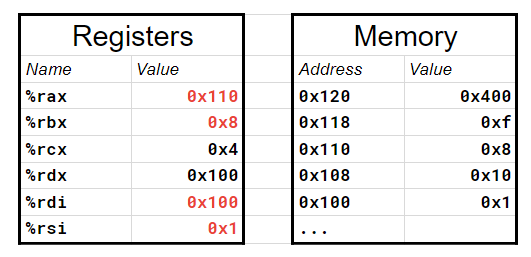CS 208 s21 — Learning Block #10
Table of Contents
1 Review
What effect do these instructions
:
leaq (%rdx,%rcx,4), %rax
movq (%rdx,%rcx,4), %rbx
leaq (%rdx), %rdi
movq (%rdx), %rsi
have on register values give the initial state below?1

2 Which condition codes indicate \(a > b\)?
- not less than and not equal
~(SF ^ OF)and~ZF~(SF ^ OF) & ~ZF
3 Conditional Exercise
Translate this C code to assembly2
long wacky(long x, long y) { long result; if (x + y > 7) { result = x; } else { result = y + 2; } return result; }
3.1 Jump Instruction Encodings
If we compile wacky and disassemble it, we can see how jump instructions are encoded into machine code3:
0000000000400497 <wacky>: 400497: 48 8d 04 37 lea (%rdi,%rsi,1),%rax 40049b: 48 83 f8 07 cmp $0x7,%rax 40049f: 7f 05 jg 4004a6 <wacky+0xf> 4004a1: 48 8d 46 02 lea 0x2(%rsi),%rax 4004a5: c3 retq 4004a6: 48 89 f8 mov %rdi,%rax 4004a9: c3 retq
- jump target encoded compactly with instruction pointer relative representation
- specify offset to the address of the immediately following instruction
7fis the encoding for thejginstruction05is the jump target, meaning it will add0x5to%rip(the instruction pointer) if it jumps- when we execute the
jginstruction,%ripis set to the address of the next instruction,0x4004a1. Adding0x5to this will result in executing themovinstruction at0x4004a6instead. objdump, the disassembler I used to produce the above example, computes this for us and displays0x4004a6as the jump target even though in the machine code the target is encoded as0x5
4 Practice
CSPP practice problems 3.16 (p. 212) and 3.18 (p. 213)
Footnotes:
2
wacky: leaq (%rdi,%rsi), %rax cmpq $7, %rax jg .L3 leaq 2(%rsi), %rax ret .L3: movq %rdi, %rax ret
3
Perform this disassembly via an option on godbolt.org

or, by putting the code for wacky and an empty main in wacky.c and running these commands:
gcc -Og -no-pie -o wacky wacky.c objdump -d wacky
objdump will print out a bunch of boilerplate assembly that's part of any program, so you'll need to locate the definition of wacky within it.
